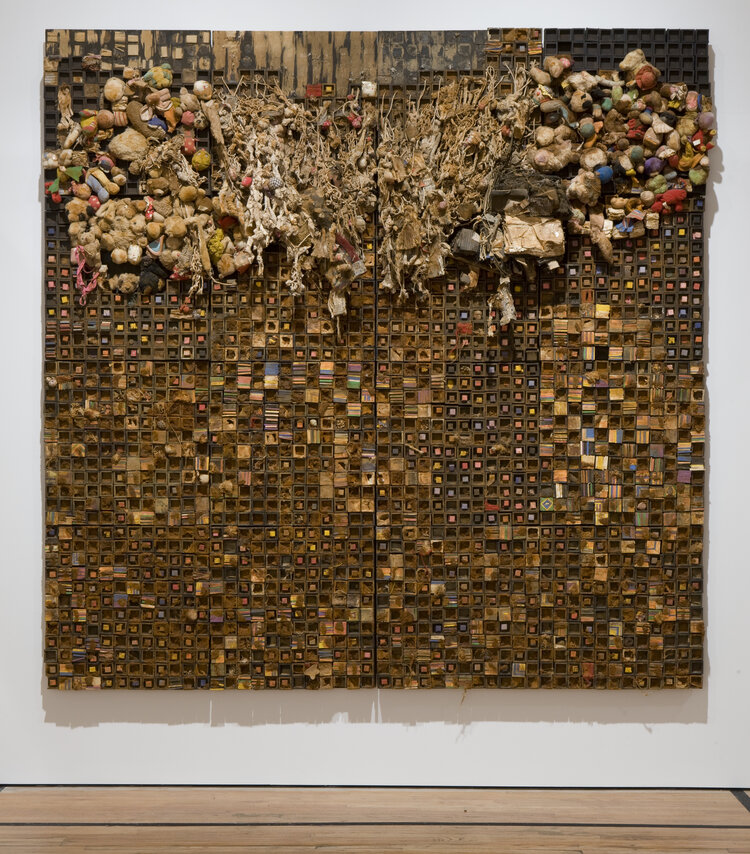This activity is developed for children ages 8 and above. Download and print this activity guide for easy reference.
How do you tell a story without words? To delve into that question, we will explore an artwork together before creating an arrangement with found objects that tells a story. This activity features a work of art from Black Refractions: Highlights from The Studio Museum in Harlem, a special exhibition at the Frye Art Museum on view May 22–August 15, 2021.

Leonardo Drew. Number 74, 1999. Rust, fabric, string, stuffed toys, and wood. 97 × 96 1/2 × 9 in. The Studio Museum in Harlem; gift of Sue Stoffel 2008.20.1. Photo Credit: Adam Reich. © Leonardo Drew. Courtesy of Sikkema Jenkins & Co., New York; Anthony Meier Fine Arts, San Francisco; Talley Dunn Gallery, Dallas; and American Federation of Arts
GET INSPIRED
Leonard Drew started creating artworks from discarded objects as a young boy, having grown up in an apartment that faced a landfill. Though his current works might seem like they are composed of found objects, the materials he uses are often created in his New York studio and made to appear weathered and aged as he explores the concept of time.
Through experimentation with materials and processes, Drew allows his work to speak for itself. He often titles his works with numbers and offers no explanations, leaving their interpretation open to viewers.
Learn more about Number 74 on The Studio Museum in Harlem’s website.
Take a moment to look closely at this artwork.
-
What is going on in this artwork? What is the first thing you notice in this work?
-
What are the objects you recognize in this work? Why do you think the artist used these objects in this work? What stories do you think the artist is trying to tell by using these objects?
-
What feelings or emotions come up as you look at this work? What do you see that makes you say that?
-
Drew often uses the grid as a way of building his artwork. A grid is a pattern or structure made from horizontal and vertical lines crossing each other to form squares or rectangles. Where have you seen a grid before? What does the grid remind you of?
-
The artist likes viewers to ask questions about his work. If you had a chance to talk to the artist, what questions would you ask about this artwork in particular?
MAKE SOME ART
Now it’s your turn to experiment with composition using found objects. Composition is the placement or arrangement of visual elements. Using objects you can find at home, you will create a 3D installation that is a visual representation of your day. This can be a day in the past that you enjoyed or an ideal way that you would like to spend a day.
You will need...
-
9 to 16 small found objects, such as toys, figurines, shells, utensils, etc.
-
Pencil and paper for writing and sketching
-
Optional: square or rectangular sheets of paper in at least two different colors
Let’s get started
-
Start listing out all the activities and events for the day. Where do you go? What do you do? Who do you see?
-
Now, gather 9 to 16 small objects from around your home that symbolize each activity, event, or people you listed for your day. In particular, think about what you see, hear, feel, smell, or touch during that experience. Are there objects that you actually use as part of the event or activity?
-
Lay your objects down on a flat surface like a desk, table, or even the floor. Take a close look at all your objects.
• How might you arrange them? Would you arrange the objects using a grid, similar to Drew’s artwork, or a different shape?• Would you organize your objects by the time of day that you use them? By color? By texture? By size?
• How might these objects interact with each other in your arrangement? -
If you decide to use a grid, one easy way to create a grid on a flat surface is to lay down 3 or 4 sheets of paper across, followed by a second row of 3 or 4 sheets of paper across, and then a final row of 3 or 4 sheets across. In total, you will use 9 or 16 sheets of paper (see the photo below for an example of a finished result). Feel free to use paper in different colors. Line up the sheets so that the sides touch each other. Each sheet of paper is now a spot where you can place your object, or you can also place your objects along the grid formed by the sheets of paper.
-
Once you have decided on your final arrangement with these found objects, take a picture or create a drawing of it. If you decide to draw, take note of the different textures, sizes, and colors of the objects.
SHARE YOUR WORK

Here is an example of a composition with selected objects to tell a story of someone’s day using a grid. How did your arrangement turn out? What’s the story you try to tell through your objects about your day? Be sure to share your creation with friends and family to see if they can guess what some of your events or activities are.
Don’t forget to share it with us on social media using #FryefromHome.
Lynn Chou
Manager of Youth and School Programs
Alexa Villanueva
2020 University of Washington, Museum Studies Certificate Program Intern